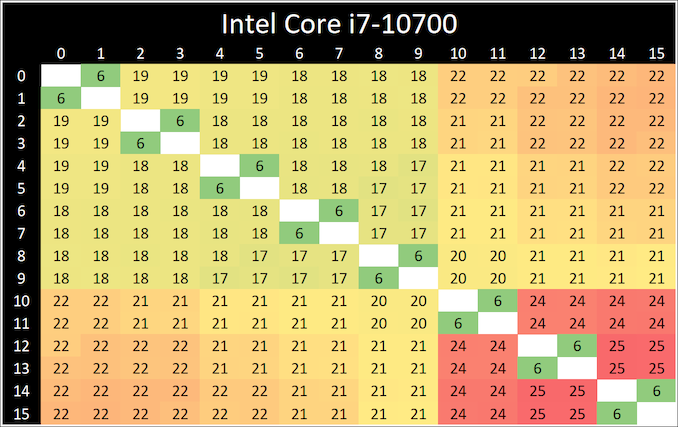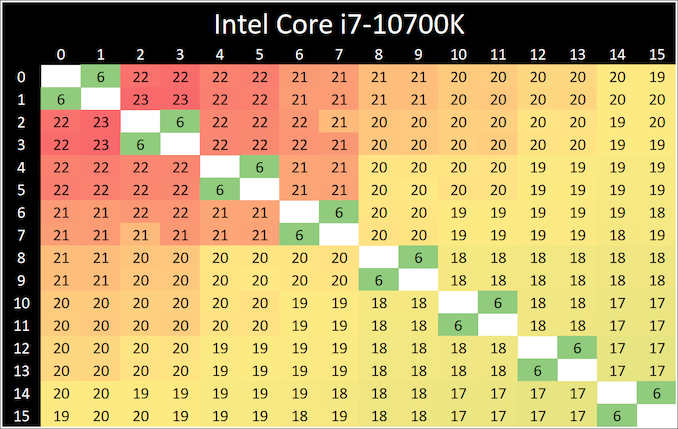Intel Core i7-10700 vs Core i7-10700K Review: Is 65W Comet Lake an Option?
by Dr. Ian Cutress on January 21, 2021 10:30 AM EST- Posted in
- CPUs
- Intel
- Core i7
- Z490
- 10th Gen Core
- Comet Lake
- i7-10700K
- i7-10700
CPU Tests: Microbenchmarks
Core-to-Core Latency
As the core count of modern CPUs is growing, we are reaching a time when the time to access each core from a different core is no longer a constant. Even before the advent of heterogeneous SoC designs, processors built on large rings or meshes can have different latencies to access the nearest core compared to the furthest core. This rings true especially in multi-socket server environments.
But modern CPUs, even desktop and consumer CPUs, can have variable access latency to get to another core. For example, in the first generation Threadripper CPUs, we had four chips on the package, each with 8 threads, and each with a different core-to-core latency depending on if it was on-die or off-die. This gets more complex with products like Lakefield, which has two different communication buses depending on which core is talking to which.
If you are a regular reader of AnandTech’s CPU reviews, you will recognize our Core-to-Core latency test. It’s a great way to show exactly how groups of cores are laid out on the silicon. This is a custom in-house test built by Andrei, and we know there are competing tests out there, but we feel ours is the most accurate to how quick an access between two cores can happen.
When we first reviewed the 10-core Comet Lake processors, we noticed that a core (or two) seemed to take slightly longer to ping/pong than the others. These two parts are both derived from the 10-core silicon but with two cores disabled, and we still see a pattern of some cores having additional latency. The ring on the 8-core parts still acts like a 10-core ring, but it all depends on which cores were disabled.
Frequency Ramping
Both AMD and Intel over the past few years have introduced features to their processors that speed up the time from when a CPU moves from idle into a high powered state. The effect of this means that users can get peak performance quicker, but the biggest knock-on effect for this is with battery life in mobile devices, especially if a system can turbo up quick and turbo down quick, ensuring that it stays in the lowest and most efficient power state for as long as possible.
Intel’s technology is called SpeedShift, although SpeedShift was not enabled until Skylake.
One of the issues though with this technology is that sometimes the adjustments in frequency can be so fast, software cannot detect them. If the frequency is changing on the order of microseconds, but your software is only probing frequency in milliseconds (or seconds), then quick changes will be missed. Not only that, as an observer probing the frequency, you could be affecting the actual turbo performance. When the CPU is changing frequency, it essentially has to pause all compute while it aligns the frequency rate of the whole core.
We wrote an extensive review analysis piece on this, called ‘Reaching for Turbo: Aligning Perception with AMD’s Frequency Metrics’, due to an issue where users were not observing the peak turbo speeds for AMD’s processors.
We got around the issue by making the frequency probing the workload causing the turbo. The software is able to detect frequency adjustments on a microsecond scale, so we can see how well a system can get to those boost frequencies. Our Frequency Ramp tool has already been in use in a number of reviews.
Both processors ramp from idle to full turbo in about six milliseconds, well within a single frame of standard gaming.













210 Comments
View All Comments
Spunjji - Friday, January 22, 2021 - link
You can infer temperature from wattage more accurately than via a temperature measurement, because that measurement depends on the configuration of the test system (cooler type, fan speeds, case airflow).Hxx - Friday, January 22, 2021 - link
thats not true because its not proportional with power draw. A 10700k uses 200+W and runs at around 70C while a 5600x uses much less power running at around the same temps. Power draw is not a good indicator and yes it comes down to your setup. Intel is just not as efficient but doesnt make it a hot chip.Oxford Guy - Sunday, January 24, 2021 - link
Yes, it does. That heat doesn't vanish into thin air. It exists.Spunjji - Monday, January 25, 2021 - link
"A 10700k uses 200+W and runs at around 70C"Again, with what cooler and fan speeds? Even accounting for the different die sizes, the only way this comparison can really be true is if there isn't an equal amount of cooling between the two processors. As OxfordGuy said, that heat has to go *somewhere*; for the temperatures to be the same between different heat loads *something* must be causing more heat to be dissipated.
vegemeister - Sunday, January 24, 2021 - link
No. IIRC all of the K variants have soldered IHS and shaved down dies. Not all of the non-K products do.Spunjji - Monday, January 25, 2021 - link
That's a point I had forgotten, and a fair one - but temps in a review still won't tell an end-user much about the temps they'll get, especially as variability can be quite high depending on the voltage an individual CPU requires to operate at its various speeds.dsplover - Friday, January 22, 2021 - link
Nobody wants Intel until they ditch 14nm. I love Intel, but I’m getting their next CPU, as well as a desktop AMD 5000 w/APU.Seems they survived their diversity exercises and are back in the game, but not until 2022.
Until then a few 4790k’s are still paying me.
Spunjji - Monday, January 25, 2021 - link
"Seems they survived their diversity exercises"Intel are doing badly, it MUST be because they stopped almost exclusively hiring white men! /s
Motivated reasoning is a disease.
Hixbot - Saturday, February 13, 2021 - link
Wow, you're really pinning Intel's faults on diversity? Meanwhile you are ignoring AMDs success is lead by an Asian American woman? You really need to check your bigotry at the door.Oxford Guy - Friday, January 22, 2021 - link
‘Specifically on the sha256 tests, both AMD and Via pull out a lead due to a dedicated sha256 compute block in each core.’VIA, eh?